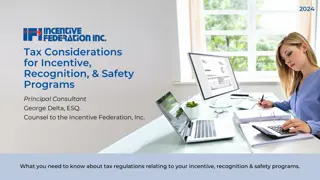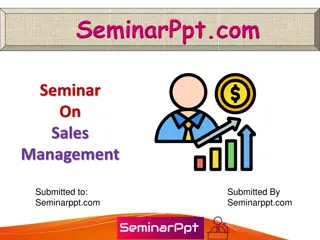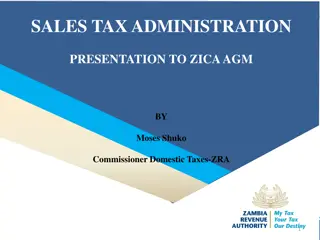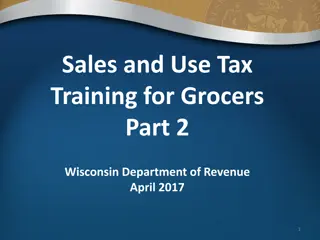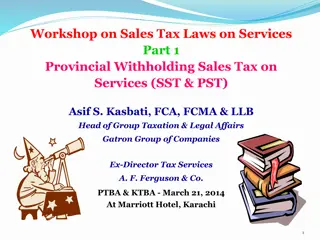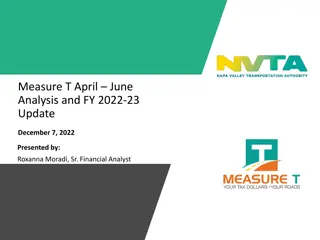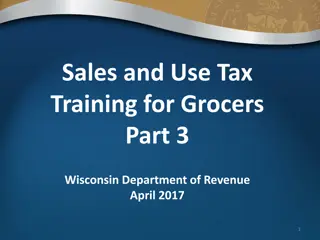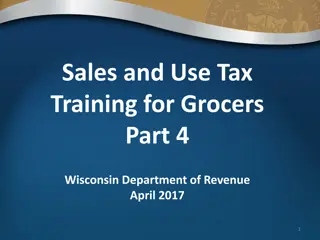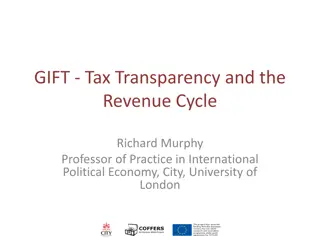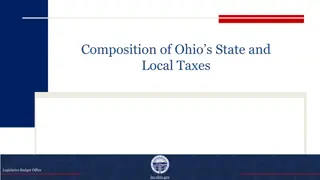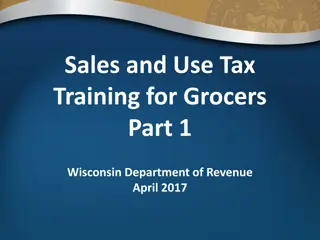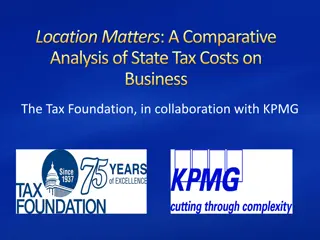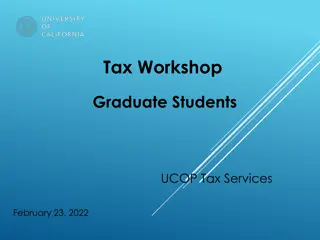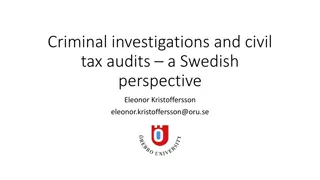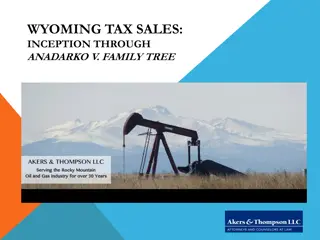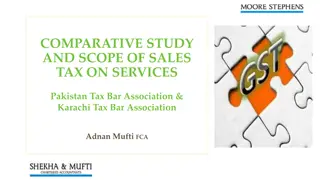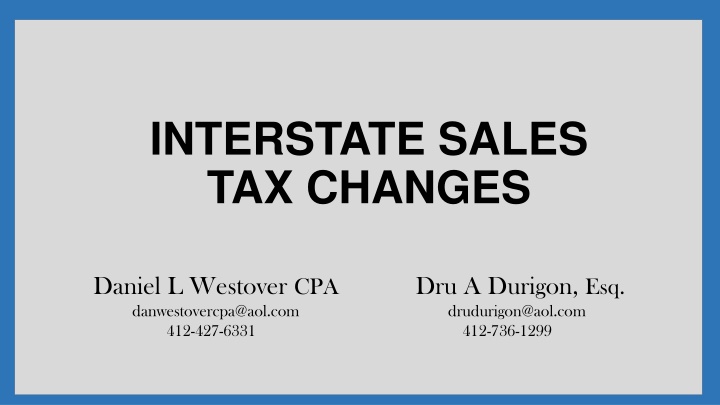
Interstate Sales Tax Changes and Wayfair Case Overview
Learn about the significant changes in interstate sales tax laws following the landmark Wayfair case, including the origins of the physical presence standard, the Wayfair checklist, multistate compliance considerations, and a list of sales and use tax compliance providers. Stay informed on the latest developments in sales tax regulations impacting businesses across state lines.
Download Presentation

Please find below an Image/Link to download the presentation.
The content on the website is provided AS IS for your information and personal use only. It may not be sold, licensed, or shared on other websites without obtaining consent from the author. If you encounter any issues during the download, it is possible that the publisher has removed the file from their server.
You are allowed to download the files provided on this website for personal or commercial use, subject to the condition that they are used lawfully. All files are the property of their respective owners.
The content on the website is provided AS IS for your information and personal use only. It may not be sold, licensed, or shared on other websites without obtaining consent from the author.
E N D
Presentation Transcript
INTERSTATE SALES TAX CHANGES Daniel L Westover CPA Dru A Durigon, Esq. danwestovercpa@aol.com drudurigon@aol.com 412-427-6331 412-736-1299
South Dakota v. Wayfair, Inc., Overstock.com, Inc., and Newegg, Inc. 138 S. Ct. 2080 (2018) Held: Because the physical presence rule of Quill is unsound and incorrect, Quill Corp. v. North Dakota, 504 U. S. 298, and National Bellas Hess, Inc. v. Department of Revenue of Ill., 386 U. S. 753, are overruled. Pp. 5 24.
Origins of Physical Presence Standard National Bellas Hess v. Department of Revenue, 386 U.S. 753 (1967) (holding that Missouri company whose only connection to Illinois was by soliciting sales through mail-order flyers, which were filled outside the state and mailed by common carrier to customers, did not have use tax nexus with Illinois). Quill Corp. v. North Dakota, 504 U.S. 298 (1992) (holding that Delaware office supply company whose only presence in North Dakota was by soliciting sales through mail-order flyers, advertisements, and phone calls, which were filled outside the state and mailed by common carrier to customers, did not have use tax nexus with North Dakota). General Rule: some sort of physical in-state presence by the out-of-state taxpayer is required to establish substantial nexus.
The Wayfair Checklist The Court provided a checklist of factors present in South Dakota law that strongly suggested why it would be constitutional under this standard: 1. Safe harbor: Exclude those who transact only limited business in the state. (South Dakota s is $100,000 in sales or 200 transactions.) 2. No retroactive collection. 3. Single state-level administration of all sales taxes in the state. 4. Uniform definitions of products and services. 5. Simplified tax rate structure. (South Dakota requires the same tax base between state and local sales tax, has only three sales tax rates, and limited exemptions from the tax.) 6. Software: Access to sales tax administration software provided by the state. 7. Immunity: Sellers who use the software are not liable for errors derived from relying on it.
Multistate Compliance Review Obtain sales/transaction reports Evaluate taxability of products and/or services Review of potential customer exemptions Evaluate method of compliance
Sales and Use Tax Compliance Providers (partial list) Accurate Tax Avalara CCH SureTax Wolters Kluwer Exactor - Intuit Onesource Thomson Reuters SAP Tax Compliance TaxCloud Taxify by Sovos TaxJar Vertex
The Setup Process Licensing with states Interaction between operating systems Mapping sales to taxability Setting up customer files by ship-to address Testing period Running live
What is sales tax nexus for sellers with an economic presence in Pennsylvania? As outlined in Sales and Use Tax Bulletin 2019-01, Pennsylvania s sales tax nexus is expanded to include businesses making at least $100,000 in annual Pennsylvania gross sales. All marketplace facilitators and online sellers who have this economic presence (e.g. Pennsylvania annual gross sales of greater than $100,000) must now register, collect and remit Pennsylvania sales tax starting July 1, 2019. The sales threshold will be measured by calendar year. After the first year, collection will begin in the second quarter to allow taxpayers adequate time to compile their calendar year sales. The collection period is July 1, 2019 through March 31, 2020 using Calendar Year 2018 sales to determine economic presence. The collection period is April 1, 2020 through March 31, 2021 using Calendar Year 2019 sales to determine economic presence. Subsequent years will follow the same collection period. Sales threshold only; no transactional count requirement. Sales are the gross amount on all channels.
How does this affect the provisions of Act 43 of 2017? Act 43 of 2017 requires certain individuals or businesses facilitating, making or referring sales to Pennsylvania customers to make an election to either: (1) register to collect and remit Pennsylvania sales tax; or (2) comply with tax notification and reporting requirements. Read more at Marketplace Sales The provisions of Act 43 remain valid law applicable to those vendors who have neither a physical presence, nor an economic presence in Pennsylvania. As noted above, all marketplace facilitators and online sellers who have this economic presence (e.g. Pennsylvania annual gross sales of greater than $100,000) must now register, collect and remit Pennsylvania sales tax. Marketplace facilitators and online sellers with annual Pennsylvania taxable sales of greater than $10,000 but less than $100,000 in total sales are required to make an election to: (1) register to collect and remit Pennsylvania sales tax; (2) comply with tax notification and reporting requirements.
Act 43 of 2017 - Remote Sellers The department estimates the revenue from the marketplace sales requirements in Act 43 of 2017 to be $174.5 million from May 2018 through March 2019. We expect collections from this source to approach $200 million by the end of the fiscal year.
PENNSYLVANIA SALES TAX ISSUES
Act 84 of 2016 (Aug. 1, 2016) Amended statutory definition of Tangible Personal Property Digitally downloaded or accessed property: Video, photographs, books, printed matter, applications ( apps ), games, music, audio service (including satellite radio service); Canned software, notwithstanding the function performed; or Any other otherwise taxable tangible personal property electronically or digitally delivered, streamed or accessed. Includes maintenance, updates and support related thereto
Act 43 of 2017 (Oct. 30, 2017) Clarified that support relates to canned software only, and that separately invoiced help desk or call center support is exempt Deadline for Petition for Reassessment to the Board of Appeals (BOA) is reduced from 90 days to 60 days of the notice of assessment mailing date. Deadline for all Petitions for Review to the Board of Finance and Revenue reduced from 90 days to 60 days from the BOA decision mailing date (includes refunds, reassessments, and redeterminations filed on or after December 29, 2017).
Letter Ruling SUT-17-001 (April 2017): Software Support Defines support services to canned software/digital property subject to tax Examples: help desk, call center and technical support services Training not subject to tax Consulting not taxable, unless it falls under the definition of support Letter Ruling SUT-17-002 (May 2017): Information Retrieval Use of information retrieval products now subject to tax as TPP (eff. 8-3-17) DOR looked to functionality and resource content of online research services Subscribers of such services exercise a license to access canned software Subscribers use the service to electronically access TPP
Sales & Use Tax Bulletin 2017-01 Review of Large and Complex Refund Requests Issued: April 10, 2017 Board of Appeals Revised REV-39 Appeal Schedule providing more information in an electronic spreadsheet format for ease of processing. New Summary Appeal Schedule to provide a high-level overview of petitions requesting in excess of $100,000 for refund with the petition. Board of Appeals refers refund petition to Bureau of Audits for field examination. Department s discretion to refer petition More than $100,000 tax and/or multiple outstanding petitions. Petitioner can be subjected to full audit for periods statutorily open to examination.
Remote Examinations DOR (PTBO) Desk Audits Department launched remote examination of sales and use tax returns in April/May 2016 Focus is on non-filers, unregistered taxpayers and under-reporters, usually in cash-based retail businesses Department compares reported activity with information from various other sources
Location of Software Ruling No. SUT-12-001 (Cloud Computing Ruling) Reversal of Position Rejected location of server test Adopted location of users test
Documentation Location of Software Percentage and number of users outside PA and detailed explanation of how number was determined Source documents in support of calculations Where software resides-server, desktop, laptop and what users have access Calculations based on users, not number of employees Account for unallocated licenses
Computer Consulting Services vs. Help Supply Services Factors favoring determination of nontaxable computer service Vendor warranty of work Fixed price, as opposed to hourly, billing High level of professional or technical expertise (may suggest service is not supervised by purchaser) Specified deliverable or finished product Purchaser s control of the time and place of performance is not supervision
Board of Appeals (BOA) Bureau within the Department of Revenue ( DoR ) Any taxpayer who is not satisfied with the DoR s assessment can petition for reassessment to the BOA within 60 days of the mailing date of the notice of assessment. Online Petition Center Preference for electronically submitted information. Prescribed schedules are available online. Request for Compromise (DBA-10), per Miscellaneous Tax Bulletin 2011-02
Board of Finance & Revenue (BFR) Within 60 days after the mailing date of the BOA s Decision & Order, the petitioner may petition for review to the BFR, which is part of the Department of Treasury. The BFR was restructured in 2014: a.Three (3) appointed members: the Chair is appointed by Treasury; the remaining 2 members are appointed by the Governor and confirmed by the Senate (6-year terms). b.Ex parte communications are prohibited, other than procedural issues. c.Both attorneys and accountants permitted to practice before it. d.Ability to compromise. e.Published decisions in a searchable database. f.The DoR is a full party to the appeal & will be at the hearing to counter- argue.

